世界贸易组织的10个主要功能
国际贸易:世界贸易组织的功能与作用

国际贸易:世界贸易组织的功能与作用1. 介绍•国际贸易是指不同国家之间进行商品和服务的交流,有助于促进全球经济发展和合作。
•世界贸易组织(World Trade Organization,简称WTO)是一个为促进国际贸易和解决贸易争端而设立的全球性国际组织。
2. 功能与任务•WTO的首要功能是协调、监督和推动全球自由贸易。
•它通过制定和实施多边贸易规则、处理成员间的纠纷以及提供技术援助等方式来履行其任务。
•WTO还提供了一个论坛,使会员国能够就各种与贸易相关问题展开对话和协商。
3. 主要职责3.1 贸易谈判•WTO通过进行多轮谈判来推动全球贸易自由化,并制定适用于所有会员国的共同规则。
•这些规则包括关税和非关税壁垒、补贴、知识产权保护等方面的内容。
3.2 纠纷解决机制•WTO设立专门机构来处理成员间因贸易争端而产生的纠纷。
•通过独立和公正的程序,WTO确保会员国在贸易争端中获得公平的待遇。
3.3 监控和报告•WTO对成员国的贸易政策进行监测,并定期发表关于全球贸易情况的报告。
•这些报告有助于提高透明度、促进信息共享,以及加强成员国之间相互监督的机制。
3.4 技术援助与容忍期•WTO为发展中国家提供技术援助,帮助他们更好地参与全球贸易体系。
•同时,它也为一些不符合某些规则的成员国提供容忍期,给予他们时间来做出必要改革。
4. 影响与意义•WTO对于全球经济稳定和可持续发展具有重要影响。
•它为各国创造了一个公平竞争环境,并降低了非关税壁垒,促进了贸易自由化和区域一体化。
•此外,WTO还鼓励成员国采取可持续发展措施,包括环境保护和劳工权益。
5. 结论•世界贸易组织以其功能和职责的履行,为促进国际贸易的自由化和公平性作出了重要贡献。
•在全球化时代,WTO的作用将变得更加重要,以应对面临的各种经济挑战和问题。
世界贸易组织名词解释

世界贸易组织名词解释世界贸易组织(WorldTradeOrganization,简称WTO)是一个国际组织,成立于1995年1月1日,旨在制定、实施与保障国际贸易以及关税减让领域的有效法规和制度框架,旨在解决国际贸易纠纷,创造有利的贸易环境,实现可持续的发展。
这一国际组织由一个贸易部门、一个服务部门、一个法律部门组成,在它的中心机构里有办公室、信息、咨询、服务、培训等功能部门。
WTO的宗旨是“通过改善贸易和投资的分配,促进发展和繁荣,协助国家实现经济发展和减少贫困”。
它的功能主要有五个:①保护和改进国际贸易秩序,提高全球经济效益;②发挥国际贸易在国家经济发展和国家和谐中的作用;③促进国际贸易的负责任发展,加强经济壁垒的解除;④保护国际贸易的基本秩序,建立公平的国际贸易制度;⑤落实国际贸易法规,保护发展中国家的利益。
目前,WTO在世界范围内拥有158个成员国,其核心机构是国际贸易政策委员会(TPC),拥有三个主要部门:贸易部(TD)、服务部(SD)和法律部(LD)。
贸易部门是WTO组织的核心机构,负责监督有关关税减让和贸易便利化的谈判,主要工作是了解各国市场情况,协助各成员国做出合理的经贸决策。
它的主要功能包括贸易政策的调整、维护国际贸易秩序、促进发展中国家参与国际贸易、制定多边贸易责任制、维护全球贸易健康发展等。
服务部门是WTO组织的分支机构,主要负责推动服务领域的谈判,促进全球服务业的发展。
它的主要功能是制定服务贸易的谅解备忘录,改善服务和投资环境,促进发达国家和发展中国家的投资,提升投资对外贸易的效率,制定服务贸易的通用规则,研究服务贸易的发展潜力,建立全球和区域性的服务贸易联盟,推动服务全球化与服务贸易发展。
法律部门是WTO组织的另一个分支机构,负责贸易法规的制定与落实,主要工作是研究和调整国际贸易规则,制定有效的国际贸易法规框架,尤其是关于发展中国家的贸易法规研究。
其主要功能有:维护国际贸易秩序、促进全球经济一体化、保护国家利益、维护发展中国家利益、分析国际贸易战略等。
世界贸易组织的建立与全球化的趋势

世界贸易组织的建立与全球化的趋势在全球化的浪潮中,世界贸易组织(World Trade Organization,简称WTO)的建立具有重要的意义。
本文将从WTO的历史背景、功能与作用、成员国情况、全球化趋势等方面进行探讨。
一、WTO的历史背景世界贸易组织的成立可以追溯到1947年,当时成立了一个叫做“关税与贸易总协定”(General Agreement on Tariffs and Trade,简称GATT)的组织。
GATT的目标是通过降低贸易壁垒,促进各国之间的贸易与经济合作。
而WTO则于1995年正式成立,取代了GATT,并扩大了其职能范围,成为一个全球性的贸易组织。
二、WTO的功能与作用WTO的主要功能是通过制定和执行多边贸易规则,维护并促进全球贸易的自由、公平和可预测性。
其具体作用包括但不限于以下几个方面:1. 贸易谈判和协商:WTO致力于通过多轮贸易谈判与协商,推动各国降低贸易壁垒、减少关税和非关税限制,并解决贸易争端。
2. 贸易规则管理:WTO制定了一系列多边贸易协议,涵盖了商品贸易、服务贸易、知识产权等领域。
这些规则的制定与管理有助于维护贸易的稳定性和可预测性。
3. 争端解决机制:WTO设立了争端解决机构,负责处理成员国之间的贸易争端。
通过该机制,可以公正、公平地解决争端,同时促进各国遵守贸易规则。
4. 技术援助与容纳发展中国家:WTO致力于支持发展中国家的经济发展和贸易能力提升,通过提供技术援助、培训项目和贸易便利化等措施,促进其融入全球贸易体系。
三、WTO的成员国情况截至目前,WTO已经拥有164个成员国,几乎涵盖了全球绝大部分经济体。
这意味着WTO的规则和协议适用于大多数国家,为全球贸易提供了一个稳定的框架。
WTO的成员国主要分为发达国家、新兴经济体和发展中国家。
发达国家在国际贸易中占据较大的份额,并在WTO决策中具有较大的影响力。
新兴经济体则在全球经济中发挥着越来越重要的作用。
高三政治国际政治练习题及答案
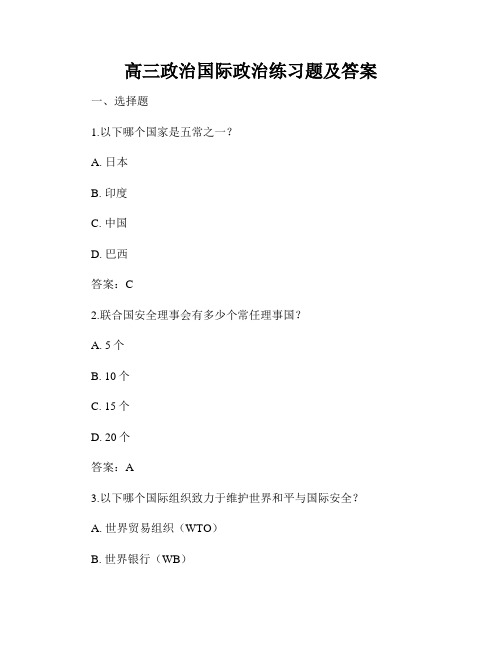
高三政治国际政治练习题及答案一、选择题1.以下哪个国家是五常之一?A. 日本B. 印度C. 中国D. 巴西答案:C2.联合国安全理事会有多少个常任理事国?A. 5个B. 10个C. 15个D. 20个答案:A3.以下哪个国际组织致力于维护世界和平与国际安全?A. 世界贸易组织(WTO)B. 世界银行(WB)C. 国际货币基金组织(IMF)D. 联合国(UN)答案:D4.下列哪个国际组织主要促进各国间的贸易合作?A. 世界贸易组织(WTO)B. 世界卫生组织(WHO)C. 亚洲开发银行(ADB)D. 国际刑警组织(INTERPOL)答案:A5.《联合国宪章》规定的国际理事会是秘书处的执行机构。
A. 正确B. 错误答案:B二、判断题6.联合国总部位于英国伦敦。
A. 正确B. 错误答案:B7.WTO是联合国附属机构之一。
A. 正确B. 错误答案:B8.安全理事会的决议必须获得全体常任理事国的一致同意。
A. 正确B. 错误答案:A9.日内瓦是国际劳工组织总部所在地。
A. 正确B. 错误答案:A10.联合国成立于1945年。
A. 正确B. 错误答案:A三、简答题11.请简要说明联合国安全理事会的主要职责。
答案:联合国安全理事会的主要职责是维护国际和平与安全。
它有权决定行动措施,包括制定决议、制裁行动等,以解决国际争端和威胁国际和平与安全的事件。
12.简述世界贸易组织的主要功能。
答案:世界贸易组织的主要功能是促进全球贸易合作,维护自由、公平、可预测的贸易环境。
它通过协商、解决争端和监督成员国遵守贸易规则等方式,推动国际贸易的发展,并促进全球经济的繁荣。
13.简述联合国秘书长的选举与任期。
答案:联合国秘书长由联合国大会推荐,经联合国安全理事会批准选举产生。
任期为五年,可连任一次。
14.简述联合国的宗旨和原则。
答案:联合国的宗旨是维护国际和平与安全,促进国际合作,解决全球性问题。
其原则包括国家平等、主权不侵犯、和平解决争端、不干涉内政、合作共赢等。
IMFWBWTO的对比分析解读

IMFWBWTO的对比分析解读IMFWBWTO是三个国际组织的缩写,分别是国际货币基金组织(IMF)、世界银行(WB)、世界贸易组织(WTO)。
这三个组织在全球经济和贸易方面扮演着重要的角色,对比分析这三个组织的功能、作用和影响力,有助于更好地理解它们对全球经济和贸易的影响。
国际货币基金组织(IMF)是全球最重要的国际金融机构之一,其主要任务是维护全球金融稳定和促进国际经济协调。
IMF的主要职责包括监测全球经济发展状况、提供财政和货币政策建议、提供紧急贷款援助以防止金融危机,以及促进全球贸易和国际投资。
IMF的成员国必须按照IMF的规则和政策来制定国内经济政策,加强国际合作。
世界银行(WB)是国际金融组织之一,致力于减轻贫困和促进可持续发展。
世界银行通过提供低息贷款和技术援助来支持发展中国家的发展项目,帮助改善基础设施、教育、卫生、农业等领域的状况。
世界银行还提供政策和经济发展建议,促进发展中国家的经济增长和减少社会不平等。
对比分析这三个组织可以从多个方面进行,包括组织结构、功能职责、政策制定和影响力。
首先,从组织结构来看,IMF和世界银行都有类似的结构,包括执行董事会、执行长和成员国代表。
而WTO则采用了一国一票的制度,每个成员国都有平等的投票权。
IMF和世界银行的成员国由富裕的发达国家主导,而WTO则更加注重平等和多边主义。
其次,从功能职责来看,IMF主要关注金融稳定和协调,提供财政和货币政策建议。
世界银行则专注于支持发展中国家的可持续发展项目。
WTO则致力于促进全球贸易自由化,并制定和推动贸易规则的执行。
可以看出,这三个组织在目标和职责上有所不同,但都关注全球经济和贸易的稳定和发展。
再次,从政策制定和影响力来看,IMF和世界银行在政策制定过程中拥有更多的决策权,并且有较强的影响力。
IMF的建议和政策往往会对成员国的经济政策产生直接影响,而世界银行通过提供贷款和援助,对发展中国家的经济和社会发展起到重要推动作用。
国家开放大学《国际法》形考任务4题库
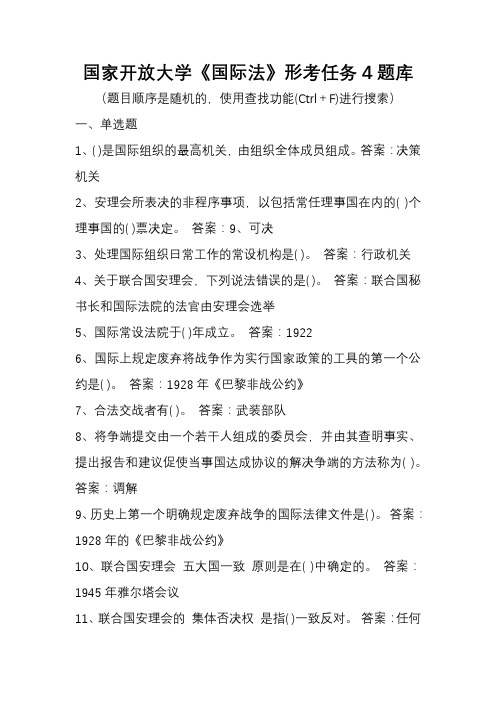
国家开放大学《国际法》形考任务4题库(题目顺序是随机的,使用查找功能(Ctrl+F)进行搜索)一、单选题1、( )是国际组织的最高机关,由组织全体成员组成。
答案:决策机关2、安理会所表决的非程序事项,以包括常任理事国在内的( )个理事国的( )票决定。
答案:9、可决3、处理国际组织日常工作的常设机构是( )。
答案:行政机关4、关于联合国安理会,下列说法错误的是( )。
答案:联合国秘书长和国际法院的法官由安理会选举5、国际常设法院于( )年成立。
答案:19226、国际上规定废弃将战争作为实行国家政策的工具的第一个公约是( )。
答案:1928年《巴黎非战公约》7、合法交战者有( )。
答案:武装部队8、将争端提交由一个若干人组成的委员会,并由其查明事实、提出报告和建议促使当事国达成协议的解决争端的方法称为( )。
答案:调解9、历史上第一个明确规定废弃战争的国际法律文件是( )。
答案:1928年的《巴黎非战公约》10、联合国安理会 五大国一致 原则是在( )中确定的。
答案:1945年雅尔塔会议11、联合国安理会的 集体否决权 是指( )一致反对。
答案:任何七个非常任理事国12、联合国大会1948年通过的全面保护个人基本权利的文件是( )。
答案:《世界人权宣言》13、联合国的创始会员国有( )。
答案:51个14、联合国的首要宗旨和目的是( )。
答案:维持世界和平与安全15、联合国国际法院除对国家外交的诉讼案件有管辖权外,还有权对联合国大会提出的法律问题发表( )。
答案:咨询意见16、联合国目前的会员国有( )。
答案:19117、联合国维持世界和平与安全首要的机关是( )。
答案:安理会18、联合国正式成立是在( )。
答案:1945年10月24日19、能够和愿意致力于某一组织的工作,被邀请或接纳参加该组织的工作,在实践中与该组织有密切联系,但不具备正式成员的资格,这样的成员叫做国际组织的( )。
wto概论期末考试题及答案

wto概论期末考试题及答案一、单项选择题(每题2分,共20分)1. WTO的全称是什么?A. 世界贸易组织B. 世界旅游组织C. 世界贸易联盟D. 世界贸易论坛答案:A2. WTO的总部设在哪个国家?A. 美国B. 瑞士C. 法国D. 英国答案:B3. WTO的前身是哪个组织?A. 关贸总协定B. 国际货币基金组织C. 世界银行D. 联合国贸易和发展会议答案:A4. WTO的主要职能是什么?A. 促进全球贸易自由化B. 协调国际货币关系C. 提供国际援助D. 维护世界和平答案:A5. WTO的成员国数量是多少?A. 164个B. 192个C. 159个D. 189个答案:A6. WTO的决策机制是什么?A. 一国一票制B. 多数票制C. 双多数制D. 一票否决制答案:C7. WTO的争端解决机制是什么?A. 仲裁B. 调解C. 诉讼D. 专家组答案:D8. WTO的贸易政策审议机制是什么?A. 定期审议B. 随机审议C. 选择性审议D. 非正式审议答案:A9. WTO的“特殊和差别待遇”原则主要针对哪些国家?A. 发达国家B. 发展中国家C. 最不发达国家D. 所有成员国答案:B10. WTO的“最惠国待遇”原则要求成员国对所有其他成员国提供什么?A. 最低关税B. 最高关税C. 同等待遇D. 不同待遇答案:C二、多项选择题(每题3分,共15分)1. 下列哪些是WTO的主要协议?A. 关税及贸易总协定B. 服务贸易总协定C. 与贸易有关的知识产权协定D. 环境协议答案:A, B, C2. WTO成员国在贸易中不得采取哪些措施?A. 出口补贴B. 进口配额C. 出口限制D. 反倾销措施答案:B, C3. WTO的基本原则包括哪些?A. 非歧视原则B. 透明度原则C. 自由贸易原则D. 公平竞争原则答案:A, B, C4. WTO的争端解决程序包括哪些阶段?A. 磋商B. 专家组审理C. 申诉机构复审D. 执行和监督答案:A, B, C, D5. 下列哪些是WTO的主要功能?A. 制定和执行国际贸易规则B. 提供争端解决机制C. 监督成员国的贸易政策D. 提供技术援助和培训答案:A, B, C, D三、判断题(每题2分,共10分)1. WTO是一个国际组织,其成员国必须遵守其制定的规则。
世界贸易组织的成立全球化与经济一体化的重要里程碑

世界贸易组织的成立全球化与经济一体化的重要里程碑世界贸易组织(World Trade Organization, WTO)是一个全球性的国际组织,于1995年成立,旨在促进全球贸易的自由化与经济一体化。
其成立被认为是全球化进程中的一个重要里程碑,对于推动世界经济的增长与发展起到了重要的作用。
一、国际贸易自由化的背景自二十世纪以来,全球贸易逐渐呈现出日益增加的趋势。
全球化进程推动了国际贸易的自由化,各国之间的贸易壁垒被逐渐打破,贸易关系更加紧密。
然而,在全球贸易自由化过程中也面临了一系列问题,如国家间的贸易争端、贸易壁垒、知识产权保护等。
因此,为解决这些问题、促进贸易自由化的进一步发展,建立一个全球贸易规则体系变得尤为重要。
二、世界贸易组织的成立与功能1. 成立背景与目的世界贸易组织的成立旨在推动全球贸易自由化、降低关税和非关税壁垒,确立公正的贸易规则,并为解决贸易争端提供机制。
通过制定并实施国际贸易规则,WTO扮演着维护全球贸易稳定和促进经济发展的角色。
2. 主要职能与原则WTO的主要职能包括贸易谈判、争端解决、监督成员国的贸易政策以及提供贸易政策支持。
其行动原则包括最惠国待遇、国民待遇、贸易自由化、公平竞争等,旨在营造公平、开放的贸易环境。
3. 争端解决机制WTO设立了争端解决机制,为成员国提供争端解决机制,提供积极、有效的解决争端的途径。
这使得WTO成为解决国际贸易争端的重要组织,维护了全球贸易秩序的稳定。
三、 WTO对全球化与经济一体化的推动1. 促进贸易自由化WTO通过推动贸易自由化,降低贸易壁垒和关税,促进了国际贸易的发展。
这无疑提高了各国经济的发展速度和经济实力,推动了全球经济一体化的进程。
2. 加强贸易规则约束WTO通过制定并实施公正的贸易规则,加强了各国之间的贸易规则约束,减少了贸易争端的发生。
这为全球贸易提供了更稳定、可预测的环境,进一步推动了全球经济一体化。
3. 促进资源配置优化WTO推动了全球资源的优化配置和合理利用,通过贸易自由化,各国可以在比较优势领域进行专业化生产,充分利用各国的资源、劳动力和技术优势,实现资源的最优配置和产业结构的优化,促进了全球经济的发展和一体化进程。
世界贸易组织的作用与挑战促进全球贸易自由化
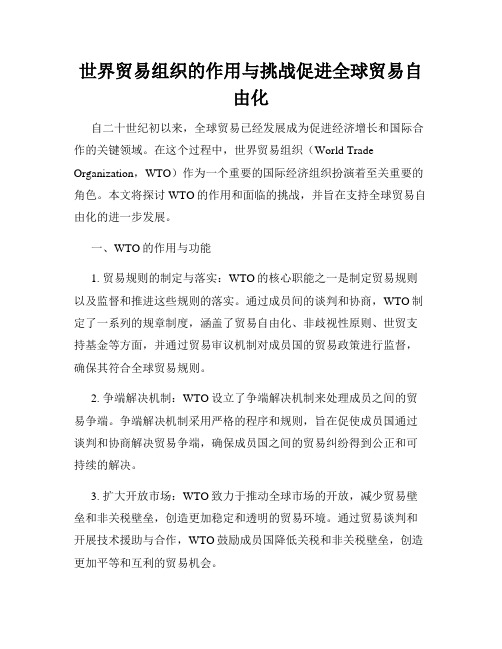
世界贸易组织的作用与挑战促进全球贸易自由化自二十世纪初以来,全球贸易已经发展成为促进经济增长和国际合作的关键领域。
在这个过程中,世界贸易组织(World Trade Organization,WTO)作为一个重要的国际经济组织扮演着至关重要的角色。
本文将探讨WTO的作用和面临的挑战,并旨在支持全球贸易自由化的进一步发展。
一、WTO的作用与功能1. 贸易规则的制定与落实:WTO的核心职能之一是制定贸易规则以及监督和推进这些规则的落实。
通过成员间的谈判和协商,WTO制定了一系列的规章制度,涵盖了贸易自由化、非歧视性原则、世贸支持基金等方面,并通过贸易审议机制对成员国的贸易政策进行监督,确保其符合全球贸易规则。
2. 争端解决机制:WTO设立了争端解决机制来处理成员之间的贸易争端。
争端解决机制采用严格的程序和规则,旨在促使成员国通过谈判和协商解决贸易争端,确保成员国之间的贸易纠纷得到公正和可持续的解决。
3. 扩大开放市场:WTO致力于推动全球市场的开放,减少贸易壁垒和非关税壁垒,创造更加稳定和透明的贸易环境。
通过贸易谈判和开展技术援助与合作,WTO鼓励成员国降低关税和非关税壁垒,创造更加平等和互利的贸易机会。
二、WTO面临的挑战1. 贸易保护主义的抬头:当前全球面临的经济下行压力和不稳定因素加大了各国对贸易保护主义的倾向。
一些国家采取贸易壁垒措施,例如提高关税、限制进口等,不仅限制了贸易自由化的推进,还可能引发贸易摩擦和贸易战。
2. 贸易谈判的复杂性与僵局:由于成员国的利益分歧和发展水平的不均衡,WTO的贸易谈判常常陷入复杂的局面。
一些发达国家和发展中国家之间难以达成一致,贸易谈判进展缓慢。
这也使得WTO难以及时应对全球贸易面临的新挑战,如数字贸易和服务贸易。
3. 对多边贸易体制的质疑:近年来,一些国家对WTO多边贸易体制提出质疑,认为其治理能力不足和执法效果不佳。
这些质疑可能导致一些国家转向双边协商和区域贸易协定,从而削弱WTO的影响力和作用。
WTO在国际经济中的作用与前景展望

WTO在国际经济中的作用与前景展望近年来,随着经济全球化的深入发展和国际贸易的快速增长,世界贸易组织(WTO)作为国际经济合作的重要平台,发挥着越来越重要的作用。
本文将从WTO的作用和其在国际经济中的前景展望两个方面进行探讨。
首先,WTO在国际经济中的作用不可小觑。
作为一个全球性的贸易组织,WTO的主要任务是促进全球贸易自由化和贸易规则的确立。
它通过制定贸易规则、解决争端、监测贸易政策等方式,在国际贸易中发挥了重要作用。
首先,WTO通过制定和维护多边贸易规则,为全球经济提供了稳定的环境。
这些规则包括减少关税和贸易壁垒、禁止歧视性贸易政策等,为各国间的经济往来提供了可靠的保障。
其次,WTO的争端解决机制是其最重要的功能之一。
争端解决机制具有法律约束力,可以帮助各成员国解决贸易争端,维护贸易规则的公正和公平。
最后,WTO还通过监测贸易政策、提供技术援助和培训等方式,促进了全球经济的可持续发展。
然而,WTO面临着一些挑战和困境,其前景也存在一定的不确定性。
首先,当前全球贸易保护主义抬头,各国之间贸易争端增多,给WTO的正常运行带来了一定的阻力。
一些国家采取单边主义行动,绕过WTO进行贸易谈判,削弱了WTO的公信力和影响力。
其次,新兴经济体的崛起和全球供应链重构给WTO带来了新的挑战。
一些新兴经济体希望在WTO中发挥更大的作用,提出了一些改革建议。
此外,数字经济的快速发展也对WTO的规则制定和监测能力提出了更高的要求。
这些问题和挑战需要WTO及其成员共同努力,寻求合作机制和解决方案。
然而,尽管面临一系列的问题,WTO的前景仍然是光明的。
首先,国际社会普遍认识到贸易自由化和多边贸易体制的重要性,多数国家积极支持WTO的工作。
其次,随着全球经济的深入发展和贸易的不断扩大,各国之间的合作和共赢将成为必然趋势。
WTO作为一个全球性贸易组织,可以发挥自身的优势,在建设开放型世界经济的进程中发挥积极作用。
此外,WTO也需要积极应对新形势下的变化,加强自身的改革和发展。
世界贸易组织(WTO)-第二章

世界贸易组织(WTO)赵维田*自从1948年哈瓦那宪章夭折,原要成立的“国际贸易组织”流产后,国际社会和国际贸易业界要求改变CATT作为国际组织的不正常状态的议论和提议,一直没有间断。
1955年对GATT 条款作大的检修时,就有改换名称,在立“贸易合作组织”(OTC),又因美国国会反对而未果。
接着,1963年联合国经社理事会又有成立国际贸易机构之议,其目的在于有一个能执行“联合国贸易与发展会议”(UNCTAD)的建议和联合国其他机构对贸易决策的机构,而将GATT变成类似“关税委员会”性质的机关。
结果由于贸易大国的反对,仅于1994年设立了“联合国贸发会”(UNCTAD),而且分工只管国际贸易中司法方面的事务。
鉴于美国国会一贯坚持反对的态度,发起乌拉圭回合多边贸易谈判的“埃斯特角部长宣言”中,在列出的诸多谈判议题中,根本没有成立国际组织这个项目。
一直到谈判进程过半的1990年,加拿大在欧共体的支持下,才提出一项内容极简单的成立“多边贸易组织”(MTO)的建议。
起初,美国仍坚持怀疑态度,后来态度有所转变。
这是因为不论从货物贸易,还是扩大到服务贸易乃至知识产权协定,都需要有个强有力的国际组织机构作依托,才得以有效执行。
何况,当时美国坚持将知识产权问题纳入乌拉圭回合的重要理由之一,是因为“世界知识产权组织”(WIPO)缺乏执法权力,想依靠GATT的有效解决争端机制。
因此,到1994年马拉喀什会议上终于达成了建立“世界贸易组织”的共识。
后来,美国国会在审议并批准乌拉圭回合一揽子协议时,虽仍存有WTO“侵害美国主权”的疑虑,但考虑到WTO只不过是把GATT已有的现状的合法化认可而已,就没有坚持反对态度。
一、三位一体的功能和GATT基本相同,用外文缩写WTO所代表的功能,有三个:国际组织,国际贸易条约群体(或称“WTO体制”)和多边贸易谈判的场所(Negotiation forum)。
这里需说明一下,WTO作为一个国际组织本应该有一个“WTO宪章”(和当年“国际贸易组织宪章”亦称“哈瓦那宪章”)一类名字来称呼规定它的实体法规则的条约[群体],这个条约或协议群的正式名称,现在叫做《多边贸易乌拉圭回合谈判成果最后文件》。
世界贸易组织的作用与未来发展趋势
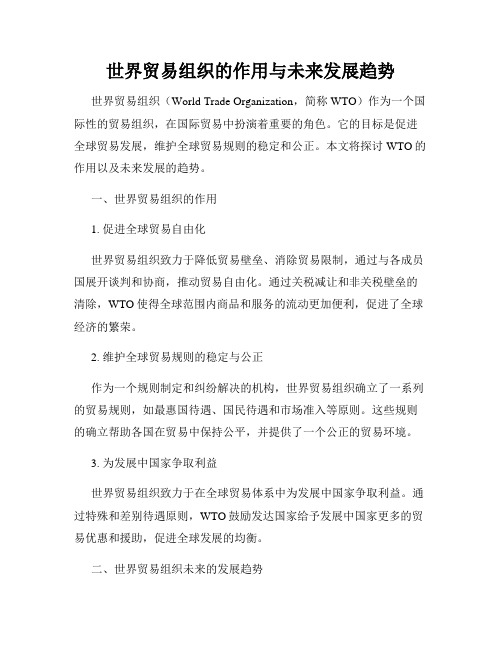
世界贸易组织的作用与未来发展趋势世界贸易组织(World Trade Organization,简称WTO)作为一个国际性的贸易组织,在国际贸易中扮演着重要的角色。
它的目标是促进全球贸易发展,维护全球贸易规则的稳定和公正。
本文将探讨WTO的作用以及未来发展的趋势。
一、世界贸易组织的作用1. 促进全球贸易自由化世界贸易组织致力于降低贸易壁垒、消除贸易限制,通过与各成员国展开谈判和协商,推动贸易自由化。
通过关税减让和非关税壁垒的清除,WTO使得全球范围内商品和服务的流动更加便利,促进了全球经济的繁荣。
2. 维护全球贸易规则的稳定与公正作为一个规则制定和纠纷解决的机构,世界贸易组织确立了一系列的贸易规则,如最惠国待遇、国民待遇和市场准入等原则。
这些规则的确立帮助各国在贸易中保持公平,并提供了一个公正的贸易环境。
3. 为发展中国家争取利益世界贸易组织致力于在全球贸易体系中为发展中国家争取利益。
通过特殊和差别待遇原则,WTO鼓励发达国家给予发展中国家更多的贸易优惠和援助,促进全球发展的均衡。
二、世界贸易组织未来的发展趋势1. 加强数字贸易和电子商务规则随着数字时代的来临,数字贸易和电子商务的重要性日益突出。
世界贸易组织将加强对数字贸易和电子商务的规则制定和监管,以适应这一新形势。
同时,WTO将致力于推动跨境数据流动的自由和数据隐私的保护,促进数字经济的发展。
2. 推动绿色贸易和环境保护全球环境问题的加剧催生了对绿色贸易和环境保护的需求。
世界贸易组织将加强环境领域的合作,通过制定环境友好的贸易规则,促进全球的可持续发展。
此外,WTO还将推动各国在贸易中采取更多的环境措施,保护生态环境和资源。
3. 加强与其他组织的合作与协调为了更好地应对全球经济挑战,世界贸易组织将加强与其他国际组织的合作与协调,如国际货币基金组织、世界银行等。
通过协同作战,不同组织可以共同应对贸易保护主义、全球经济不确定性等问题,推动全球经济的稳定和发展。
世界贸易组织与国际贸易规则

世界贸易组织与国际贸易规则世界贸易组织(World Trade Organization, WTO)是一个全球性的国际组织,其主要目标是推动全球贸易的自由化和促进成员国之间的贸易发展。
作为一个多边贸易体制的基石,世界贸易组织通过制定和推行一系列的国际贸易规则,为成员国提供一个公平、透明和可预测的贸易环境。
一、世界贸易组织的成立背景二战后,各国纷纷意识到建立一个稳定的全球贸易体系的重要性,为此在1947年成立了关贸总协定(General Agreement on Tariffs and Trade, GATT)作为早期全球贸易体制的核心。
随着全球经济的快速发展,1986年乌拉圭回合谈判开始,最终在1995年建立了现在的世界贸易组织,取代了GATT。
二、世界贸易组织的职责和功能世界贸易组织的核心职责是通过制定和实施国际贸易规则来促进全球贸易的自由化。
其具体功能包括:1. 磋商与协商:世界贸易组织为成员国之间进行贸易问题的磋商和协商提供了平台,促进成员国之间的合作和交流,增进贸易合作机会。
2. 争端解决:世界贸易组织设立了一个争端解决机构,负责处理成员国之间的贸易争端。
通过公正、透明和有效的争端解决机制,保护成员国的贸易权益,维护多边贸易体制的稳定。
3. 监督和审议:世界贸易组织对成员国之间的贸易政策进行定期审议和监督,确保成员国遵守国际贸易规则,防止出现不正当贸易行为。
4. 技术援助:世界贸易组织通过技术援助机构,向发展中国家提供相关培训和技术支持,帮助他们更好地参与全球贸易并受益于贸易自由化。
三、国际贸易规则的基本原则世界贸易组织制定的国际贸易规则基于以下几个基本原则:1. 最惠国待遇:成员国应当对所有成员国给予最惠国待遇,即对任何一方成员国实施的关税和非关税壁垒,都必须向其他成员国同样适用。
2. 国民待遇:成员国在对进口商品征收关税和其他贸易壁垒时,应当与对本国商品一样对待来自其他成员国的商品。
经济全球化与世界贸易组织

经济全球化与世界贸易组织引言经济全球化是指国际社会中经济活动的日益全球化趋势。
世界贸易组织(WTO)作为国际贸易体制的核心机构,扮演着推动全球经济合作、促进贸易自由化和经济全球化的重要角色。
本文将探讨经济全球化与世界贸易组织之间的关系,以及世界贸易组织在乱序时期维护经济全球化的作用。
经济全球化的定义与特点经济全球化是指国际贸易、跨国投资、国际间劳动力流动等经济活动在全球范围内日益密切地联系和相互依存的程度。
它主要表现为以下几个方面的特点:1.跨国公司的崛起和壮大:跨国公司在全球范围内进行商业活动,通过投资和资源配置的方式促进全球经济一体化。
2.国际贸易的增加:国际间商品和服务的交流交易规模不断扩大,贸易逐渐成为各国之间经济联系的重要方式。
3.国际间资本流动的扩大:跨国投资的增加推动了跨国公司的发展,也促进了各国经济的互动和合作。
4.科技革新的推动:信息技术的发展使全球范围内的交流更加便捷,推动了经济全球化的进程。
经济全球化的加深为各国带来了机遇和挑战。
它能够促进资源优化配置和效益提升,推动技术创新和产业升级,提高生活水平和经济发展水平。
然而,也会带来经济波动和不平等现象,使发展中国家面临更大的挑战。
世界贸易组织的起源与功能世界贸易组织(WTO)作为国际贸易体制的核心机构,是由成员国共同组成的国际组织。
它的成立旨在促进贸易自由化和公平竞争,并提供一个解决贸易争端和制定贸易政策的实质性平台。
WTO的主要功能包括:1.推动贸易自由化:WTO通过多边贸易谈判,推动成员国降低关税、取消非关税壁垒和限制措施,促进贸易自由化和市场开放。
2.解决贸易争端:WTO通过建立一个法律和权威性的争端解决机制,帮助成员国解决贸易争端,并确保成员国遵守规则和承诺。
3.提供贸易政策协调和协商的平台:WTO为成员国提供一个平等参与贸易政策协调和协商的平台,促进成员国之间的合作与交流。
4.提供技术援助和培训:WTO通过为发展中国家提供技术援助和培训,帮助其在全球贸易体系中更好地参与并受益。
《世界贸易组织》课件

《世界贸易组织》PPT课 件
这个PPT课件将介绍世界贸易组织(WTO)的历史、功能、工作原则、会议 与决策过程、对全球贸易的影响以及未来展望。
什么是世界贸易组织(WTO)?
WTO是全球最重要的贸易组织之一,致力于促进国际贸易的自由化和公平化。我们将介绍其历史、成员国和 机构以及目标和作用。
WTO的工作原则
WTO的会议和决策过程
1
会议的决策过程
2
会议成员通过协商和投票来做出决策,
确保每个成员国都有发言权。
3
会议类型和频率
WTO通过不同类型的会议来讨论和决定 重要议题,频率取决于需求。
WTO贸易谈判的规则
贸易谈判遵循特定的规则和程序,以确 保公平和平衡的贸易协议。
WTO影响世界贸易
1 全球贸易的增长
资金自由、贸易自由、制度自由
WTO旨在促进资金、货物和服务的自由流动, 以及解决贸易制度上的障碍。
贸易准则和禁止歧视
WTO制定了贸易准则,禁止对来自其他成员国 的产品进行歧视性对待。
数字化贸易和知识产权保护
WTO关注数字化贸易和知识产权保护的重要性, 以适应不断发展的经济环境。
环境保护和社会责任
WTO努力确保贸易自由化和环境保护之间的平 衡,同时考虑社会责任。
WTO的活动和准则促进了全球贸易的增长, 为各国带来了经济繁荣。
2 国际间的贸易争端
WTO解决了许多国际贸易争端,确保了公正 和强制执行的贸易规则。
3 更公平的贸易
WTO致力于减少发达和发展中国家之间的贸 易壁垒,实现更公平的贸易机会。
4 贸易保护主义的挑战
WTO面临贸易保护主义的挑战,需要寻找解 决方案以维护贸易自由化。
世界贸易组织的功能与作用剖析

世界贸易组织的功能与作用剖析随着全球化的加速发展,贸易成为各国经济发展的重要推动力。
而世界贸易组织(World Trade Organization,简称WTO)作为国际贸易规则的制定者和执行者,扮演着至关重要的角色。
本文将对世界贸易组织的功能与作用进行剖析,以期更好地理解WTO对全球贸易的影响。
首先,世界贸易组织的主要功能之一是促进贸易自由化。
WTO通过制定和推动贸易规则的全球统一,鼓励各成员国之间的贸易自由化和开放。
这一功能的核心在于通过减少贸易壁垒,提高市场准入,促进商品、服务和资本的自由流动。
通过降低关税和非关税壁垒,WTO为各国提供了更大的市场准入机会,促进了全球贸易的增长。
其次,世界贸易组织还扮演着促进公平贸易的角色。
WTO致力于建立公平的贸易环境,避免不公平的贸易行为和歧视性的贸易措施。
通过制定并执行贸易规则,WTO确保各成员国在贸易中享有平等的机会和待遇。
此外,WTO还设立了争端解决机制,以解决成员国之间的贸易争端,维护公平贸易的原则。
第三,世界贸易组织还具有促进经济发展的作用。
WTO通过推动贸易自由化和公平化,为各国提供了更广阔的发展机遇。
贸易自由化可以促进资源的优化配置和技术的传播,激发经济增长的潜力。
此外,WTO还通过技术援助和贸易便利化等措施,帮助发展中国家提升贸易能力,促进其经济的可持续发展。
然而,世界贸易组织也面临着一些挑战和争议。
首先,WTO在贸易自由化方面的进展并不平衡。
发达国家在贸易谈判中往往占据主导地位,而发展中国家的利益则常常受到忽视。
这导致了一些发展中国家对WTO的不满和质疑。
其次,WTO在应对新兴问题和挑战方面的能力相对较弱。
随着全球经济的变化和新技术的出现,一些新兴问题如数字贸易、知识产权保护等对WTO提出了新的挑战,需要WTO加强自身的适应能力。
为了更好地发挥作用,世界贸易组织需要不断改革和创新。
首先,WTO应加强与其他国际组织和机构的合作,形成更加协调一致的国际贸易体系。
国际贸易管理制度
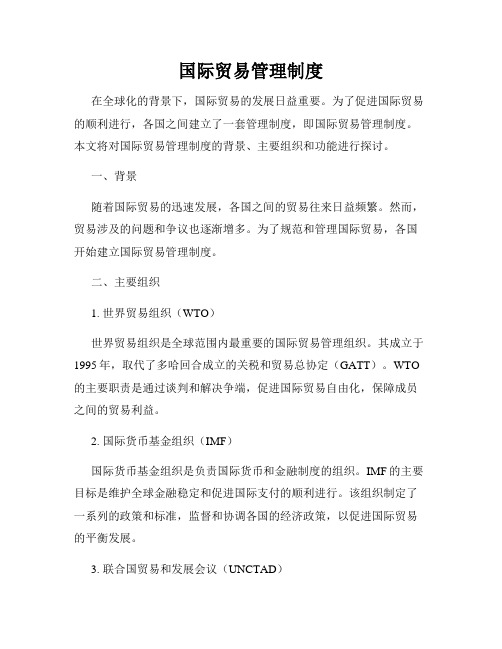
国际贸易管理制度在全球化的背景下,国际贸易的发展日益重要。
为了促进国际贸易的顺利进行,各国之间建立了一套管理制度,即国际贸易管理制度。
本文将对国际贸易管理制度的背景、主要组织和功能进行探讨。
一、背景随着国际贸易的迅速发展,各国之间的贸易往来日益频繁。
然而,贸易涉及的问题和争议也逐渐增多。
为了规范和管理国际贸易,各国开始建立国际贸易管理制度。
二、主要组织1. 世界贸易组织(WTO)世界贸易组织是全球范围内最重要的国际贸易管理组织。
其成立于1995年,取代了多哈回合成立的关税和贸易总协定(GATT)。
WTO 的主要职责是通过谈判和解决争端,促进国际贸易自由化,保障成员之间的贸易利益。
2. 国际货币基金组织(IMF)国际货币基金组织是负责国际货币和金融制度的组织。
IMF的主要目标是维护全球金融稳定和促进国际支付的顺利进行。
该组织制定了一系列的政策和标准,监督和协调各国的经济政策,以促进国际贸易的平衡发展。
3. 联合国贸易和发展会议(UNCTAD)联合国贸易和发展会议是联合国负责贸易和发展问题的专门机构。
UNCTAD致力于通过提供政策建议和技术援助,推动贸易的公平和可持续发展。
该组织在促进发展中国家参与国际贸易和制定贸易政策方面发挥着重要作用。
三、功能1. 促进贸易自由化国际贸易管理制度的重要功能之一是促进贸易自由化。
通过建立多边贸易协定和减少关税壁垒,国际贸易得以更加顺利地进行。
WTO的谈判机制和争端解决机制,在推动贸易自由化方面起到了重要作用。
2. 维护贸易规则和纪律国际贸易管理制度的另一个功能是维护贸易规则和纪律。
各国在加入WTO之前需要承诺遵守其规则,包括关税和非关税壁垒的限制。
此外,国际贸易组织还通过争端解决机制来解决成员之间的贸易争议,确保贸易规则得到合理执行。
3. 保障贸易利益和发展中国家权益国际贸易管理制度还致力于保障各成员国的贸易利益,特别是发展中国家的权益。
联合国贸发会议和国际货币基金组织等组织通过提供技术援助和资金支持,帮助发展中国家克服贸易壁垒和发展贸易。
认识WTO的功能及规则
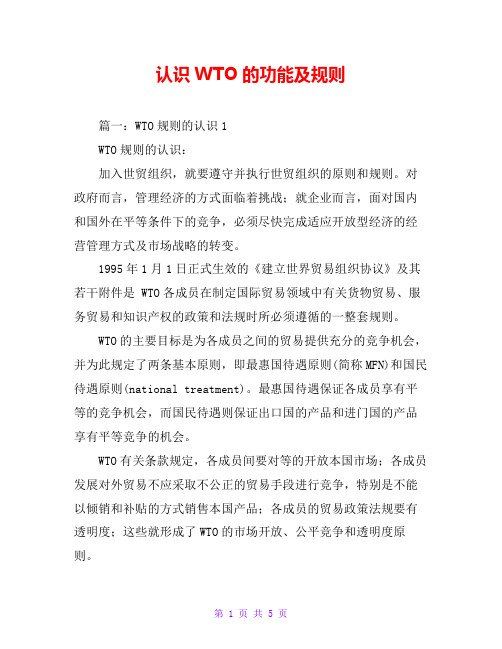
认识WTO的功能及规则篇一:WTO规则的认识1WTO规则的认识:加入世贸组织,就要遵守并执行世贸组织的原则和规则。
对政府而言,管理经济的方式面临着挑战;就企业而言,面对国内和国外在平等条件下的竞争,必须尽快完成适应开放型经济的经营管理方式及市场战略的转变。
1995年1月1日正式生效的《建立世界贸易组织协议》及其若干附件是 WTO各成员在制定国际贸易领域中有关货物贸易、服务贸易和知识产权的政策和法规时所必须遵循的一整套规则。
WTO的主要目标是为各成员之间的贸易提供充分的竞争机会,并为此规定了两条基本原则,即最惠国待遇原则(简称MFN)和国民待遇原则(national treatment)。
最惠国待遇保证各成员享有平等的竞争机会,而国民待遇则保证出口国的产品和进门国的产品享有平等竞争的机会。
WTO有关条款规定,各成员间要对等的开放本国市场;各成员发展对外贸易不应采取不公正的贸易手段进行竞争,特别是不能以倾销和补贴的方式销售本国产品;各成员的贸易政策法规要有透明度;这些就形成了WTO的市场开放、公平竞争和透明度原则。
上限制定了规则。
非关税措施不允许普遍使用。
例如,一成员一殷不得禁止或限制货物的进口或出口。
实施此类非关税措施有明确的前提条件,而且只能通过规定的程序加以实施。
WTO规定了这些条件和程序。
例如,一成员可以提高产品的关税或实行数量限制,保护其国内产业免受进口激增的冲击。
若遇到国际收支困难,也可以采取措施减少进口。
同时,在有关协议中对采取上述行动的条件和程序作出了详细的规定。
为确保竞争机会的连续性,WTO反对不公平的贸易做法,并提供了保护公平贸易的措施。
例如,若某成员对其出口或生产进行补贴,或某公司通过不合理地降低产品价格进行倾销,受到不利影响的成员则可以采取措施,抵消这些不公平贸易做法所带来的影响。
在国际贸易中,有时存在变相的贸易壁垒,比如对产品的质量或性能规定不必要的高标准、或者高估进口产品价值以征收不合理的高额关税。
高一政治 怎样认识世界贸易组织的性质、职能和原则素材 人教版

怎样认识世界贸易组织的性质、职能和原则【问题提出与解析思路】世界贸易组织是世界上最大的多边贸易组织,加入世界贸易组织是中国加快对外开放、积极参与经济全球化的重要举措。
世界贸易组织的性质、职能和原则等都是教材规定的重要内容,掌握这些内容,对于深刻理解入世对我国经济贸易的影响,我国积极参与经济全球化的态度、全面提高对外开放水平和自主自力更生的原则等都是非常重要的。
为了使教师对世界贸易组织有比较完整的认识,我们这里系统地介绍和阐述了如下问题:WTO的性质和法律地位、WTO的基本职能和组织体系、WTO的基本原则等三大方面的内容,特别是对WTO的基本原则做了比较详细的分析。
【问题解析】一、WTO的性质和法律地位WTO,即世界贸易组织(World Trade Organization —WTO),是当今世界上惟一处理国与国之间贸易规则的国际组织,与国际货币基金组织(IMF)、世界银行三足鼎立,成为当今世界经济秩序中贸易、金融和发展三大领域中维持贸易秩序的主要支柱。
由于世界贸易组织从法律上具备健全的国际法人资格,协调管理领域宽,规则严格,并通过贸易政策审议机制、争端解决机制、补贴纪律、可持续发展、服务贸易自由化、知识产权保护和贸易政策、法规的透明度等基本原则,对世界经济贸易的发展产生着重大的影响,就其现有的职能和协调范围而言,已成为名副其实的“经济联合国”。
世界贸易组织的前身是关贸总协定(GATT)。
由于GATT从产生之日起就是作为拟成立而未能成立起来的“国际贸易组织”的临时性条约,具有先天不足。
随着世界经济、科技的迅猛发展,GATT的局限性日益显露出来,主要表现在:GATT的法律地位不明确,限制了其设计功能的发挥,影响了其管理和协调世界经济贸易的作用;GATT的法律责任不明晰,往往造成GATT对缔约方在援引例外条款时“违规”而无能为力;GATT 无法适应国际服务贸易和保护知识产权等新变化的需要;GATT缺乏强有力的规制约束力,最为突出的是缺乏强有力的国际贸易争端解决机制。
世界贸易组织的成立与全球化的影响

世界贸易组织的成立与全球化的影响自20世纪末,“全球化”这一词汇开始频繁出现在各类媒体与公共讨论中。
全球化带来了无数利益和机会,但也引发了许多贸易争端和经济不平等的问题。
在这一背景下,世界贸易组织(WTO)的成立对全球贸易和经济发展产生了重要影响。
一、世界贸易组织的成立与背景世界贸易组织是于1995年成立的国际经济组织,其前身为1948年成立的关税及贸易总协定(GATT)系统。
GATT的目标是通过减少贸易壁垒和增加贸易自由来推动全球贸易的发展。
然而,随着全球化的加速和全球贸易规模的不断扩大,原有的GATT已经无法满足现代贸易需求。
二、世界贸易组织的功能与作用世界贸易组织的成立为全球贸易体系建立了更加完善和稳定的规则。
作为一个框架性组织,WTO的主要功能包括:贸易谈判、争端解决、政策审议和技术援助与合作。
通过这些功能,WTO力图推动全球经济的发展,加强国际贸易的自由化和公平性。
三、全球化对世界贸易组织的影响全球化的快速发展为世界贸易组织带来了挑战和机遇。
一方面,全球化推动了贸易自由化和减少贸易壁垒的要求,促使世界贸易组织进一步完善规则与机制。
另一方面,由于全球化的不平等性和贸易争端的增加,世界贸易组织也面临着协调国家和地区利益的压力。
四、世界贸易组织对全球化的积极影响通过降低贸易壁垒和增加贸易自由,世界贸易组织为全球经济提供了更加稳定和可持续的增长环境。
它促进了国际贸易的扩大,为各国提供了更多的机会和选择。
世界贸易组织还通过规范贸易行为、保护知识产权和促进技术转移等方面,推动了全球贸易的发展。
五、世界贸易组织对全球化的挑战与改革尽管世界贸易组织在推动全球贸易和经济发展方面发挥了重要作用,但它也面临着一些挑战。
世界贸易组织与全球化的不平衡和不公平现象有关,一些发展中国家认为自己在国际贸易中的地位不平等。
因此,世界贸易组织需要进行一定的改革,以确保更加公正和平等的全球贸易体系。
六、结论世界贸易组织的成立为全球化提供了一个更加稳定和可持续的贸易框架。
- 1、下载文档前请自行甄别文档内容的完整性,平台不提供额外的编辑、内容补充、找答案等附加服务。
- 2、"仅部分预览"的文档,不可在线预览部分如存在完整性等问题,可反馈申请退款(可完整预览的文档不适用该条件!)。
- 3、如文档侵犯您的权益,请联系客服反馈,我们会尽快为您处理(人工客服工作时间:9:00-18:30)。
page 1 … c ut living costs and raise living standards 22 … s ettle disputes and reduce trade tensions 103 … stimulate economic growth and employment 144 … c ut the cost of doing business internationally205 … encourage good governance 266 … help countries develop 307 … give the weak a stronger voice 368 … s upport the environment and health 409 … contribute to peace and stability 4610 … be effective without hitting the headlines 5010 things the WTO can do The W TO can ...The world is complex. The World Trade Organization is complex. This booklet is brief, but it tries to reflect the complex and dynamic nature of trade and the WTO’s trade rules. It highlights benefits of the trading system, but it doesn’t claim that everything is perfect. Were it a perfect system, there would be no need for further negotiations and for the system to evolve and reform continually.Nor does this booklet claim that everyone agrees about everything in the WTO. That’s one of the most important reasons for having the system: it’s a forum for countries to thrash out their differences on trade issues.That said, there are a number of reasons why we’re better off with the system than without it.What’s the WTO’s view on …? The WTO is its members. With over 150 members, the WTO has over 150 views — probably more than that, too.by trade policies.Protectionism is expensive: it raises prices. The WTO’s global system lowers trade barriers through negotiation and operates under the principle of non-discrimination.The result is reduced costs of production (because imports used in production are cheaper), reduced prices of finished goods and services, more choice and ultimatelya lower cost of living.Elsewhere, we look at the challenges that imports can present. Here the focus is on the impact on us, as consumers.Overall incomes can rise. Trade opening since 1945 has boosted US annual incomes by $1 trillion, or $9,000 per household, according to the US government . Two major trade agreements of the 1990s — the WTO Uruguay Round and the North American Free Trade Agreement between the US, Canada, and Mexico — generate increased purchasing power of $1,300 to $2,000 per year for the average American family of four, it says.The European Union, which, through the creation of its single market undertook the third major liberalization at the turn of the century, says the gains from the wider variety of goods and services available to the average European consumer are in the range of €600 a year,in addition to the gains from lower prices.Food is cheaper if protection is reduced. When you protect your agriculture, food is artificially expensive. When protection is particularly high — as when market pricesare naturally low — the impact can be huge. Protecting agriculture raised food prices byan estimated $1,500 per year for a family of four in the European Union in 1997 and bythe equivalent of a 51% tax on food in Japan (1995). In just one year (1988), US consumers had $3 billion added to their grocery bills just to support sugar.But there is also a paradox. Protectionand subsidies in rich markets raise prices domestically but force down prices externally in world markets and particularly in poorer countries. If reform in the developed world raises world prices, consumers in the poorer countries may suffer, but their farmers receive more realistic prices, encouraging them to produce more and improving supplies within the country.Negotiating agricultural trade reform is therefore a complex undertaking. Governments are still debating the roles agricultural policies play in a range of issues from food security to environmental protection.But WTO members are now reducing the subsidies and the trade barriers that are the worst offenders. And they are negotiatingto continue the reform in agriculture.1 ... cut living costs and raise living standards These issues have now been incorporatedinto a broader work programme, the DohaDevelopment Agenda, launched at the fourthWTO Ministerial Conference in Doha, Qatar,in November 2001.Clothes are cheaper. Like agriculture, tradein garments and textiles has been reformedalthough some protection remains. At timesof peak protection, the costs to consumerswere high.In the US, import restrictions and highcustoms duties combined to raise US textilesand clothing prices by 58% in the late 1980sduring the early years of the negotiations thatproduced global reform — the Uruguay Roundtalks that created the WTO.UK consumers paid an estimated £500 millionmore per year for their clothing because ofthese restrictions. For Canadians, the bill wasaround C$780 million. For Australians, it wouldhave been A$300 annually per average familyif Australian customs duties had not beenreduced in this period.Reform of the textiles and clothing tradeunder the WTO was completed in 2005.The programme included eliminatingrestrictions on quantities of imports.Even now, the import duties on cheaperessential products can be a disproportionateburden on the neediest.If customs duties on textiles and clothingwere also to be eliminated, economistscalculated that the result could be a gainto the world of around $23 billion, including$12.3 billion for the US, $0.8 billion for Canada,$2.2 billion for the EU and around $8 billionfor developing countries.In the Republic of Korea,protectionism in the car industryadds around 43% to the cost ofan imported carTrade opening since 1945 hasboosted US annual incomes by$9,000 per householdProtecting agriculture raised foodprices by an estimated $1,500 peryear for a family of four in theEuropean Union in 19971945After tax2012Before tax$30000$21000The same goes for other goods …For example, it is estimated that at their peak in the early 1980s, quotas on cars imported into the US were transferring $5 billion a year in additional profits to Japanese car makers (and additional costs to consumers), who could sell their quota-limited cars at a premium.Despite this protection, the US car industry continued to lose market share. Foreign producers simply jumped over the trade barrier and began manufacturing cars in the US. Many other countries have also protected their car industries. In the Republic of Korea,for example, the combination of an 8% tariff and taxes on engine size add about $9,000to the price tag of a $30,000 imported car.… and services. In Africa, Tanzania, Uganda and Mozambique were among the countries with the highest price drops for telephone, Internet and other forms of communications services in 2008-10. So were Bhutan and Bangladesh in Asia, according to calculations by the International Telecommunications Union (ITU). Recent market opening inleast-developed countries is beginningto show dividends.From 2008 to 2010, Internet broadband prices in developing countries (as a proportion of gross domestic product or GDP) declined much more rapidly, by 52%, than in rich countries, at 35%. Today, hardly any countries still allow Internet services to be provided under monopoly rights.More broadly, according to ITU data, regionsthat have liberalized telecoms more slowly andless fully — the Middle East and Africa — showhigher average price levels than regions suchas Europe, the Americas and Asia, whichembraced reform earlier.And businesses as well as citizens benefit.Price reductions and affordability resultingfrom market opening around the world meanthat telecoms services reach more small andmedium-sized enterprises too.Tariffs often hurt the poor. According tostudies in the United States, higher tariffsare charged on a number of products thatare bought by lower-income sections of thepopulation. These include sports shoes,underwear, T-shirts and much more — meaningthese consumers pay tariff rates five to tentimes higher than middle-class or rich familiespay in upmarket shops. Poorer exportingcountries, such as Cambodia and Bangladesh,are also hurt: they face tariffs 15 times higherthan those applied to wealthy nations andoil exporters.And so it goes on. The system now entrustedto the WTO has been in place for over 60 years.In that time, there have been eight major roundsof trade negotiations. Trade barriers aroundthe world are lower than they have ever beenin modern trading history. They continue to fall,and we are all benefiting.According to critics of agriculturalprotectionism, consumers andgovernments in rich countries havepaid $350 billion per year supportingagriculture — enough to fly their 41million dairy cows first class aroundthe world one and a half times.Differing points of view: food securityFirst, trade isn’t – and never was – a silver bullet. Not for food security or really any other purpose. Trade offers important advantages, and when it works well, it reduces costs, improves consumer options, and assists inmanaging risks. But over-reliance on trade– either as importers or exporters – has realeconomic and food security risks.— Gawain Kripke , Oxfam America Director of Policyand Research, “Finding some focus: Trade and foodsecurity, the politics of poverty”, Oxfam Americawebsite, 6 June 2012Food security is the elephant in the room whichthe WTO must address. Trade did not feed thehungry when food was cheap and abundant,and is even less able to do so now that pricesare sky-high. Global food imports shall be worth$1.3 trillion in 2011, and the food import billsof the least developed countries have soaredby over a third over the last year. The G-20 hasacknowledged that excessive reliance on foodimports has left people in developing countriesincreasingly vulnerable to price shocks and foodshortages. The WTO must now do the same.— Olivier De Schutter , Special Rapporteur on the Right toFood, “Food security hostage to trade in WTO negotiations –UN right to food expert”, Office of the UN High Commissionerfor Human Rights website, 16 November 2011I fundamentally disagree with your assertion that countries need to limit reliance on international trade to achieve food security objectives. On the contrary, there is agreement among most UN-led experts that international trade is part of the package of solutions to achieve food security.The UN High Level Task Force on the Global Food Security […] noted that ‘more liberalized international markets would contribute to global food and nutrition security through increased trade volumes and access to diverse sources of food imports.’ […]The Inter-agency report for the G-20 stated, for example, that ‘trade is an essential componentof any food security strategy’ and that ‘policiesthat distort production and trade in agriculturalcommodities potentially impede the achievementof long run food security’. […]Indeed, our members negotiate towards a morelevel playing field in agriculture in order toenhance their ability to achieve food security.— Pascal Lamy, WTO Director-General,letter to Olivier De Schutter, 14 December 2011More trade, more traded The WTO can ...goods and services andmore trading countries— they bring benefits butthey can also increasethe potential for friction.The WTO’s system dealswith these in two ways.One is by talking:countries negotiate rulesthat are acceptable to all.The other is by settlingdisputes about whethercountries are playing bythose agreed rules.The relationshipThe WTO can ...between trade and jobsis complex. It is true thattrade can create jobs,but it is equally true thatcompetition from importscan put producers underpressure and lead themto lay off workers.The impact ofcompetition from foreignproducers varies acrossfirms in a sector, acrosssectors of the economyas well as acrosscountries. So does theimpact of new tradeopportunities.Many of the benefits The WTO can ...of the trading systemare more difficult tosummarize in numbers,but they are stillimportant.They are the result ofessential principles at theheart of the system, andthey make life simpler forthe enterprises directlyinvolved in trade and forthe producers of goodsand services.2021‘Made in … where?’The Boeing Dreamliner aircraft may be made in America, but with essential imports sourced from so many other places thatit’s difficult to know where to begin.And there’s a turbine engine exhaust nozzle,brought in from Mexico from titanium sheetsmade in China. Those are just the first threetelling examples that show up from a glancethrough US Customs records – with eachimport necessary to the American workers in places like Everton.Source: Greg Rushford, “Made in America?”, 21 February 2012, Rushford Report, There’s the Integrated Surveillance System Processor and an Integrated Navigation Radio, from Canada.There’s also a Valve Control Unit from Germany – passengers can thank that for keeping their cabin air pressure within tolerable limits.That doesn’t even get to the big-ticket items:the Rolls-Royce Trent 1000 engine, thetesting in wind tunnels in the UK and France;the Mitsubishi Heavy Industries’ wing; Italianhorizontal stabilizers, doors from France, andother critical components from Sweden, India,South Korea – it’s a very long list.The Dreamliner is as cosmopolitan as theAmerican people. Boeing’s American workersshould love imports, because their jobs dependupon them.SurveillanceSystem Processorfrom CanadaAutomatedpassenger doorsfrom FranceIntegratedNavigation Radiofrom Canada.Engine exhaust nozzle from MexicoTitanium sheetsfrom China Horizontal stabilizersfrom FranceRolls-Royce Trent engine from UK and France Mitsubishi Heavy Industries’ wing from Japan2425Transparency — shared The WTO can ...information andknowledge — levelsthe playing field.Rules reducearbitrariness andopportunitiesfor corruption.They also shieldgovernments fromlobbying by narrowinterests.2627Underlying the WTO’s The WTO can ...trading system is thefact that more opentrade can boosteconomic growth andhelp countries develop.In that sense, commerceand development aregood for each other.In addition, the WTOagreements are full ofprovisions that take intoaccount the interests ofdeveloping countries.30313233Over three-quarters of WTO members aredeveloping or least-developed countries. All of those in the queue to join are likewise developing countries. Whether the interests of developing countries are well enough served in the WTO is a subject of continuing debate. But even the most critical developing countries acknowledge that the system offers them benefits.In fact, few economists dispute that properly handled, trade is essential for development.All WTO agreements contain specialprovisions for developing countries, includinglonger periods to implement agreements and commitments, measures to increase their trading opportunities and support to help them build the infrastructure for WTO work, handle disputes, and implement technical standards. Least-developed countries receive special treatment, including exemption from many provisions. The needs of developing countries can also be used to justify actions that might not normally be allowed under the agreements – for example, governments giving certain subsidies.And the negotiations and other work launched at the Doha Ministerial Conference in November 2001 include numerous issues that developing countries want to pursue.6 ... help countries develop75%of WTO membersare developing countries.Small countries would The WTO can ...be weaker without theWTO. Differences inbargaining power arenarrowed by agreedrules, consensusdecision-making andcoalition building.Coalitions givedeveloping countriesa stronger voice innegotiations. Theresulting agreementsmean that all countries,including the mostpowerful, have to playby the rules. The ruleof law replaces might-makes-right.36373839The WTO trains of cials from developing countries so that they can work more effectively in the system.WTO geopolitics are evolving. In recent years, developing countries have become considerably more active in all areas of the WTO’s work. They made sure development would be at the heart of the Doha Round talks and submitted an unprecedented number of proposals on agriculture and other subjects.They are active in all WTO councils and committees. They have set up numerous coalitions to increase their bargaining power, particularly in negotiations. Some of these are developing country coalitions; some are mixed, working on shared interests that cut across developed-developing country boundaries.Until the mid-1990s, the “Quad” — the US, EU, Japan and Canada, then the largest traders — were seen as the most powerful consensus-brokers. Now, any attempt to break a major deadlock has to include at least some of the major emerging economies and representatives of various coalitions, including the least-developed countries.Once the rules have been agreed, all countries are equal under them. That also applies to the dispute settlement system, which is similar to a court. This century, except in a handful of years, developing countries have filed complaints in at least half of all legal disputes, sometimes considerably more. And their complaints are against both developed and developing countries. Without the WTO, these smaller countries would have been powerless to act against their more powerful trading partners. There wouldn’t be much point in a “multilateral” trading system if that weren’t the case.One important point about the WTO is the practice of reaching decisions by consensus. Every country has to be convinced before agreement can be reached. Compromise is key: whatever is proposed has to be refined until it is acceptable to everyone or more precisely until it is objectionable to no one. Consensus means there are no dissenters.Another is the agreed rules. All countries, big or small, weak or powerful, have to follow broadly the same rules. There are exceptions, delays or flexibilities for poorer countries, but they are still the same package of rules — the flexibilities are just a way of allowing these poorer countries to play by the rules.The rules are the result of negotiations and consensus decisions , and have been ratified in members’ parliaments. The negotiation that set up the WTO, the Uruguay Round (1986-94), was only possible because of a bargain. Developed countries agreed to reform trade in textiles and agriculture — both issues were important for developing countries.And then there’s assistance Technical assistance and training. This is an area where the WTO is actively involved in aid. The WTO trains officials from developing countries so that they can work more effectively in the system. That includes training on how to negotiate effectively within the rules. Each year, the WTO organizes around 100 seminars, workshops and other training sessions for these officials. They also come to Geneva for longer trade policy courses. Legal advice. Not part of the WTO but associated with it is an Advisory Centre on WTO Law in Geneva. The centre gives low-cost legal advice and training on WTO law to developing countries, and supports them in WTO dispute settlement proceedings at discounted rates. The centre enables these countries to fully understand their rights and obligations under WTO law and to have an equal opportunity to defend their interests in WTO dispute settlement cases (www.acwl.ch).Academic institutions . A Chairs Programme set up by the WTO aims to help academic institutions in developing countries increase trade knowledge and contribute to the development of trade policy (see /chairprogramme). 7 ... give the weak a stronger voiceAn often-heardThe WTO can ...accusation is that theWTO system treatstrade as the priority,at the expense ofenvironmental andhumanitarian objectives.This is untrue.404147This is an under-reported benefit of the WTO’s trading system.Trade helps to sustain growth.Trade rules stabilize the world economy by discouraging sharp backward steps in policy and by making policy more predictable. They deter protectionism; they increase certainty. They are confidence-builders.51Negotiations and disputes are news-makers, but a lot of vital WTO work takes place out of the limelight to help trade flow smoothly, for the benefit of the world economy and for all of us.WTO FACT FILELocation: Geneva, Switzerland ------------------------------------------------------------------------------------Established: 1 January 1995 ------------------------------------------------------------------------------------Created by: Uruguay Round GATT negotiations (1986–94) ------------------------------------------------------------------------------------Membership:157 countries* on 24 August 2012 ------------------------------------------------------------------------------------Budget: 196 million Swiss francs for 2012 ------------------------------------------------------------------------------------Secretariat staff: 646 (at end 2011)76 nationalities55% women, 45% men ------------------------------------------------------------------------------------Head: Pascal Lamy (Director-General) ------------------------------------------------------------------------------------Functions: • Administering WTO trade agreements • Forum for trade negotiations• Handling trade disputes• Monitoring national trade policies• T echnical assistance and trainingfor developing countries• C ooperation with other internationalorganizations © World Trade OrganizationISBN: 978-92-870-3831-9Written by the Information and External Relations Division, WTO Designed by BergHind Joseph Printed by the WTOWorld Trade Organization154 Rue de LausanneCH–1211 Geneva 21 SwitzerlandTel: +41 (0)22 739 5111 Fax: +41 (0)22 739 4206 Email: enquiries@WTO PublicationsEmail: publications@ WTO Online Bookshop: * In this booklet, the word “country” is used to describe WTO members. However, a few members are officially “customs territories” and not necessarily countries in the usual sense of the word. Follow the WTO:。
